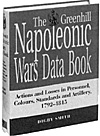
Author: Digby Smith (alias Otto von Pivka)
Pages: 582
Illustrations: None
Maps: None
Footnotes: None
Appendices: None
Bibliography: 208 primary and secondary sources, many in languages other than English.
Index: Approximately 1, 100 entries.
Publisher: Greenhill Books, London (available in the U.S. through Stackpole Books, PA)
Publication Date: 1998
Binding: Cloth (hardbound)
ISBN: 1-85367-276-9
Price: $69.95
Summary: An amazingly comprehensive work from a frequent contributor to the Osprey series of Napoleonic information books, Digby Smith has succeeded in compiling a useful data base of nearly every military action of the Revolutionary and Napoleonic Wars, in chronological
order. There are some problems with the sources utilized (especially for the Peninsular War and the Russian Campaign of 1812) as well as with the casualty figures cited. Nonetheless,
this work is destined to become a standard reference for the period, and is well worth the price.
The Greenhill Napoleonic Wars Data Book is a monumental contribution to the study of the military actions during the French Revolution and Napoleonic era. The result - culled from archives, libraries and private collections in Austria, Britain, France, Germany, the Netherlands, Russia, Scandinavia, Spain, Switzerland, Poland and Portugal - is quite impressive in its scope and magnitude. Based on more than twenty years of research, this massively detailed reference work lists more than 2,000 skirmishes, raids, ambushes, clashes, captures, battles, blockades, and sieges which took place from 1792 to 1815 in Europe, Russia and the Middle East. The chronological layout gives an overview of the range and intensity of the military activity in time, allowing the reader to place events within the context of the conflict in Europe as a whole and in direct relation to other campaigns. Each entry includes the date and type of action (skirmish, raid, ambush, etc.), precise location, winner of the action, names of the opposing commanders, actual units involved in the fighting (from company to corps level), total number of troops involved on each side, losses for each side (dead, wounded and captured), and trophies lost or captured (colors, standards, artillery and wagons). The author included a brief commentary highlighting significant events as well as errors or consequences of the action. There is an alphabetical index of battles and engagements for quick reference, as well as a robust bibliography.
Unfortunately, the work contains flaws that, given the book's ambitions, seem inevitable. It falls short of the highest expectations when it comes to the exploitation of primary foreign sources - presumably, Smith had to limit his research in order to finish the book. Thus, many actions are insufficiently researched in order to make the account highly reliable. Additionally, despite discussing the dilemma at length in the book's introduction, Smith fails to provide any insight as to how he reconciles various casualty estimates for a particular engagement.
These shortcomings appear to be the result of a couple of factors. First is Smith's failure, evident in several of his previous books (written under the pseudonym of Otto von Pivka), to clearly cite all his sources. That he has exploited primary source material is obvious from the depth of detail provided throughout his many works. Unfortunately, the reader is sometimes left guessing as to the exact nature of those sources. In the same vein, one suspects that Smith has left a great deal out of his bibliography.
Another constraining factor is the author's clear preference for German sources. Fortunately, the author uses these to marvelous effect, often providing insight into even the most obscure military actions. Thus, the portions of the book dealing with the French campaigns in Germany, Prussia and Austria as well as with the relevant armies are generally superior to the remainder.
Though they are far from minor, the book's shortcomings do not seriously detract from its overall utility. Military history buffs will find this work is a joy to peruse and makes an excellent starting point whenever one wishes to study a particular engagement. Digby Smith has succeeded in producing a book that should be on the bookshelf of every serious student of the battles of the period.
More Book Reviews
-
Book Review: The Greenhill Napoleonic Wars Data Book
Book Review: Napoleon: How He Did It
Book Review: A Soldier for Napoleon
Book Review: 1815 The Waterloo Campaign
Book News
Back to Table of Contents -- Napoleon #14
Back to Napoleon List of Issues
Back to MagWeb Master Magazine List
© Copyright 1999 by Napoleon LLC.
This article appears in MagWeb (Magazine Web) on the Internet World Wide Web.
The full text and graphics from other military history magazines and gaming magazines are available at http://www.magweb.com
Order Napoleon magazine direct